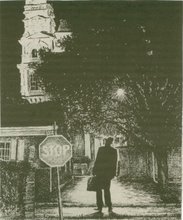
 (John Sloan's Sunflowers, Rocky Neck; Dolly Sloan [left] and John Sloan [right] with Alice Beach Winter, Stuart Davis and others at the "Red Cottage" on East Main Street, 1915. Images from Cape Ann Historical Association)
(John Sloan's Sunflowers, Rocky Neck; Dolly Sloan [left] and John Sloan [right] with Alice Beach Winter, Stuart Davis and others at the "Red Cottage" on East Main Street, 1915. Images from Cape Ann Historical Association)
Just as Gloucester is a city of hills, it
It is worth the search, for there are marvelous gardens to be discovered—Turks’ caps breaking out between fence pickets, xenias suddenly exploding in color, gladioli where you’d least expect them.
The
From photographs taken by Winter you can see the flower beds that surrounded the cottage, which has been beautifully preserved and is still painted a wonderful dark red. And from Sloan’s paintings-he did nearly a hundred that first summer-you can discover his neighbors’ gardens, and those on Rocky Neck and Mt. Pleasant Avenue that are depicted on his bright canvases.
On exhibit at the Cape Ann Historical Association is one of the earliest and finest of Sloan’s
This painting is important, not only because it’s an initial example of Sloan’s Gloucester period, but also because in it he pays homage to that great painter of sunflowers, Vincent Van Gogh, some of whose works Sloan had encountered in New York the year before at the Famous “Armory Show,” which brought European modernism to America and changed the face of American art.
Sloan walked the moors behind his house, painting granite boulders half the size of barns and cows grazing peacefully in that still pastoral time. There’s a spectacular painting he did of Dogtown, also at the Historical Museum, a painting whose tints of purple and dark green perfectly capture the primordial atmosphere of Dogtown before Marsden Hartley made it his own.
I can imagine Sloan on those
The Gloucester of Sloan’s day must have been a wonder for city people like John and Dolly, both native Philadelphians. They picnicked with visitors by the ocean and on the ledges above the Seine Fields. They made friends with the neighborhood children, many of whom Sloan painted.
Again and again in Sloan’s paintings you discover the gardens of
It was the same in my childhood many years after the Sloans left
Italian and Portuguese families recreated the gardens of
The flowers and vegetables people grow, the gardens they create, say a lot about who we are and how we feel about our lives-indeed about the places we live in. Walk the neighborhoods of the inner city and you will discover a world of pattern and color in gardens that thrive even during the hottest summers. These gardens are the life of the city.


No comments:
Post a Comment